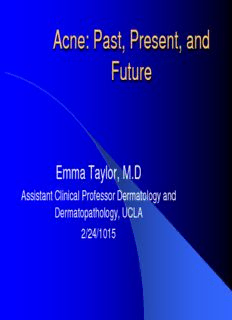
Download Presentation File PDF
Preview Download Presentation File
Acne: Past, Present, and Future Emma Taylor, M.D Assistant Clinical Professor Dermatology and Dermatopathology, UCLA 2/24/1015 Disclosures Cofounder, President, and CEO of Skinomics.INC Acne: A Historical Perspective Ancient Egyptian Aku-t -boils, blains, sores, pustules, inflamed swelling Fuchs 1840 coined-Acne Vulgaris, Acne Mentagra and Acne Rosacea Bloch 1931 proved relationship acne to puberty Acne and the First Therapies Ancient Egypt, Greece, and Rome used sulfur treatments 1920s: Benzoyl Peroxide introduced 1970s: Tretinoin (original Retin A), antibiotics (minocycline) 1980s: Accutane introduced – >2000 women became pregnant between 1982 and 2003, majority ending in miscarriage – 160 babies with defects born – Ipledge system established Acne Epidemiology Today Acne affects >80% of the population O ver 50 million people in the US, and over 150 million in the seven major markets. It is among the top 5 most economically burdensome skin diseases in the US Total costs predicted to exceed $3 billion 2016 However, market revenues are stagnant due to patent expirations, generic competition, lack of long term efficacy Acne Pathogenesis Inflammation Overgrowth Propionibacterium acnes Increased androgens, sebum production Abnormal differentiation of keratinocytes Acne Pathogenesis Genetic and Environmental Factors Strong familial predisposition related to severity Diet inconclusive-possible relation to high glycemic index Smoking exacerbates Hormonal influences-worsens in puberty Medications-lithium, corticosteroids, vitamin B12 Stress Types of Acne Comedonal Inflammatory Nodulocystic Scarring Current Acne Therapies Topicals – Benzoyl Peroxide – Retinoids – Antibiotics – Misc (, Azaleic Acid,sulfacetamide sulfur, Dapsone gel, glycolic acid, salyclic acid, natural products) Orals – Antibiotics (doxycycline, minocycline) – Isotretinoin – Antihormonals (Spironolactone, OCPs) Procedures – Light therapy (PDT) – Dermabrasion/Extraction/Injections
Description: